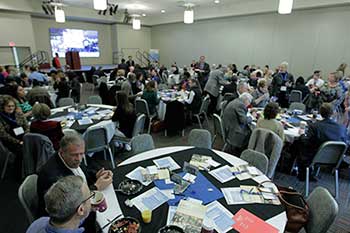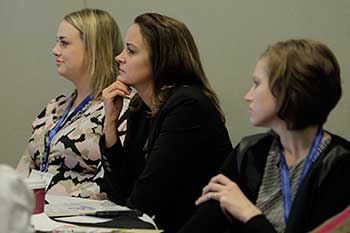A Look Within—UWG Hosts State of Community: Carroll
by Bonnie Butcher
It is a great opportunity to gather and collaborate with others on the very issues that influence the community everyone shares. On February 25 the University of West Georgia raised awareness of the state of the community, focusing on Carroll County. The event brought the community and university together to take a closer look at the places we call “home.”
 “When we heard from our community that they wanted a place to go for reliable and useful information to help others understand our community, for valid data about who Carroll county is, we knew that the College of Social Sciences had to step up and fill this need,” said Dr. N. Jane McCandless, dean of the College of Social Sciences (COSS). “This is a place where we can come and share information about issues effecting our quality of life, issues that each one of us as residents and leaders must be aware of.”
“When we heard from our community that they wanted a place to go for reliable and useful information to help others understand our community, for valid data about who Carroll county is, we knew that the College of Social Sciences had to step up and fill this need,” said Dr. N. Jane McCandless, dean of the College of Social Sciences (COSS). “This is a place where we can come and share information about issues effecting our quality of life, issues that each one of us as residents and leaders must be aware of.”
The morning breakfast and presentation began with a current census overview. Carroll County has a population of 111,872 with an average family size of 3.25. The median age is 33.9 years old. The population is made up of 51.3 percent female and 48.7 percent male.
The average income in Georgia has been stagnant, despite the average income increasing in the United States. In Carroll County, the average income has been slightly decreasing. During this decline, the number of people living below the federal poverty line in Carroll County has increased.
Data shows that there are many pockets of challenged neighborhoods in our community, with areas concentrated with high poverty, lack of health insurance, and lack of a high school degree.
Crime and criminal behavior is highly emphasized in our society more than ever before. This can sometimes give people the notion that things are getting worse, but that is not the case. An analysis of data revealed crime has been decreasing in Carroll County, a very similar trend to the rest of the country.
“You can see that the United States and Georgia have violent crime rates that are pretty similar, and you should feel great because Carroll County is a lot safer,” said Dr. Elizabeth Stupi, assistant professor of criminology and director of the Survey Research Center. “We see a lot less violent crime in Carroll County than in other areas.”
“I want everyone to think about how important it is to base our ideas about policy, and about what we should do, on actual information,” said Dr. Winston Tripp, assistant professor of sociology and director of the data analysis and visualization lab. “Just because we see something on the news, the South is very different, and Carroll County is even more unique in many ways.”
In an election year, it is hard to go a day without hearing something about the presidential election on the news. Looking at the data, there are some interesting findings within Carroll County on the issue of voting.
“Carroll County, generally speaking, follows the national patterns with decreasing voter turnouts from national elections to state elections to municipal elections,” said Dr. J. Salvador Peralta, associate professor and chair of political science. “What is slightly different though, is that in most places in the United States, cities have slightly higher voter turnout than rural areas. In Carroll County, it tends to be slightly different.”
What Dr. Peralta was referring to is that in rural areas of Carroll County, such as Roopville, Tyus, and Bowdon, there is a consistent pattern of higher voter turnout. Urban areas of Carroll County such as Carrollton and Villa Rica show a consistent pattern of lower voter turnout.
“One of the central assumptions of American democracy is that people participate, because it is supposed to be the people’s choice,” said Dr. Peralta. “But then the question becomes, whose choice is it really, when only slightly over 10 percent of the population vote. That’s a really important question that should be in everybody’s mind.”
Dr. Jeannette Diaz, associate professor of psychology, spoke about community based participatory research. One project conducted was a focus group with Carroll County residents aimed at understanding the food and nutrition challenges faced by low-income residents. The project was funded through Tanner Health System’s Community Transformation Grant, and data was collected with the assistance of master’s students in the psychology department.
Research found that low-income residents of Carroll County face numerous challenges when it comes to health and nutrition.
The cycle of food stamp (SNAP) disbursements becomes problematic when the food runs out before the end of that cycle. This leaves parents scrambling, wondering where they will get their next meal. Some find a saving grace in the local food banks, but with a lack of transportation, this isn’t always possible.
With Carroll County’s nonexistent public transportation, many residents struggle to find a way to even get to the grocery store. These issues have become a serious barrier to health and wellness among residents of our community.
 “The increase in obesity that we often see in low income families, while related to a host of issues, such as the cheaper cost of high calorie foods, is also hypothesized to be related to children’s development in response to a cycle of nutritional surplus and scarcity that follows the cycle of food benefits disbursement,” said Dr. Diaz. “Within the context, the developing body learns to store fat at a higher rate than those circumstance where caloric intake is constant.”
“The increase in obesity that we often see in low income families, while related to a host of issues, such as the cheaper cost of high calorie foods, is also hypothesized to be related to children’s development in response to a cycle of nutritional surplus and scarcity that follows the cycle of food benefits disbursement,” said Dr. Diaz. “Within the context, the developing body learns to store fat at a higher rate than those circumstance where caloric intake is constant.”
In the spirit of health and wellness, Professor and Chair of Anthropology Dr. Lisa Gezon, along with students, conducted a survey focused on use of the Carrollton Greenbelt. From October to November of 2015, 269 face-to-face surveys were collected.
The data showed that the typical Greenbelt user is between the ages of 35-44 and has an annual household income between $50-75K. Women and men use the Greenbelt in distinctly different ways in terms of health benefits, activity level and duration, and social interaction.
The morning presentation was followed by professional development workshops for all in attendance. These presentations focused on topics of leadership, data collection and analyzation, and grant writing for nonprofits.
“I think one of the big takeaways from today is the dedication of the College of Social Sciences and our faculty, staff, and administrators who are dedicated to serving humanity and doing public good in Carroll County and in the cities and areas through out region,” said Dr. Amber Smallwood, associate dean of the COSS.
Do you have a comment or opinion about this story's topic? Perspective Online wants to hear from you. Submit a letter to the editor today.
